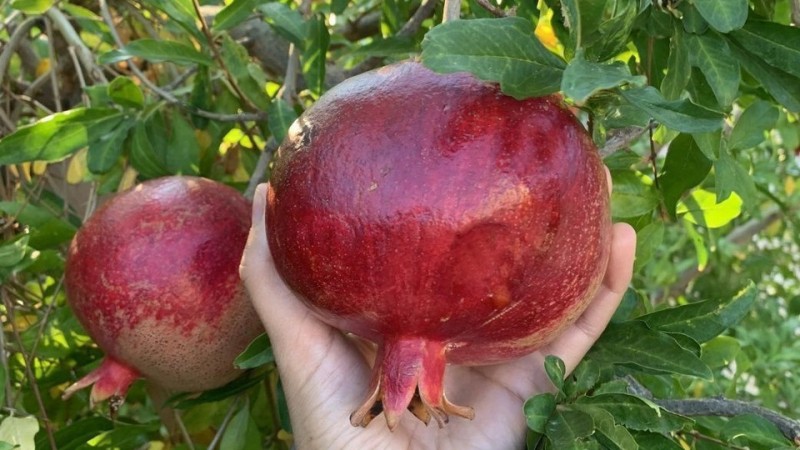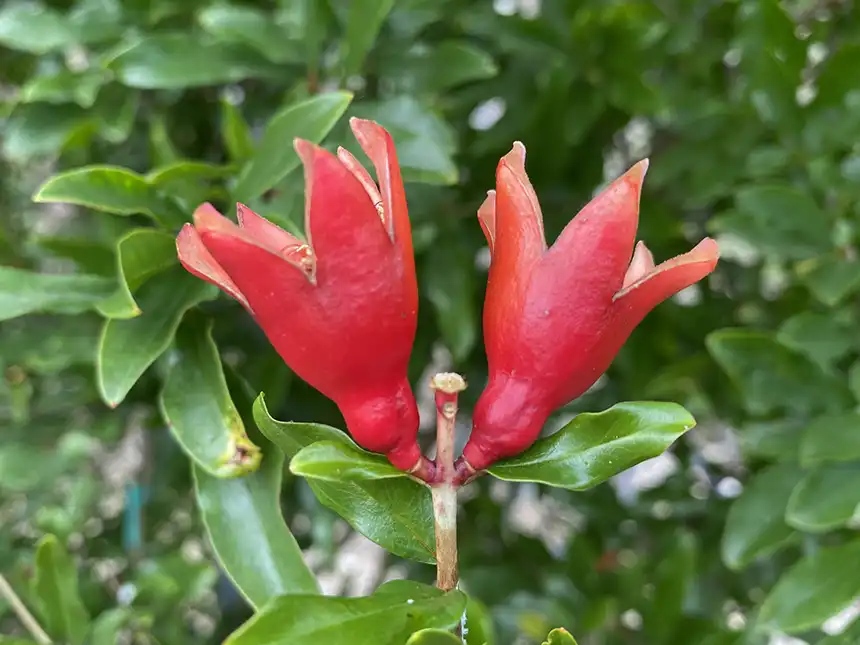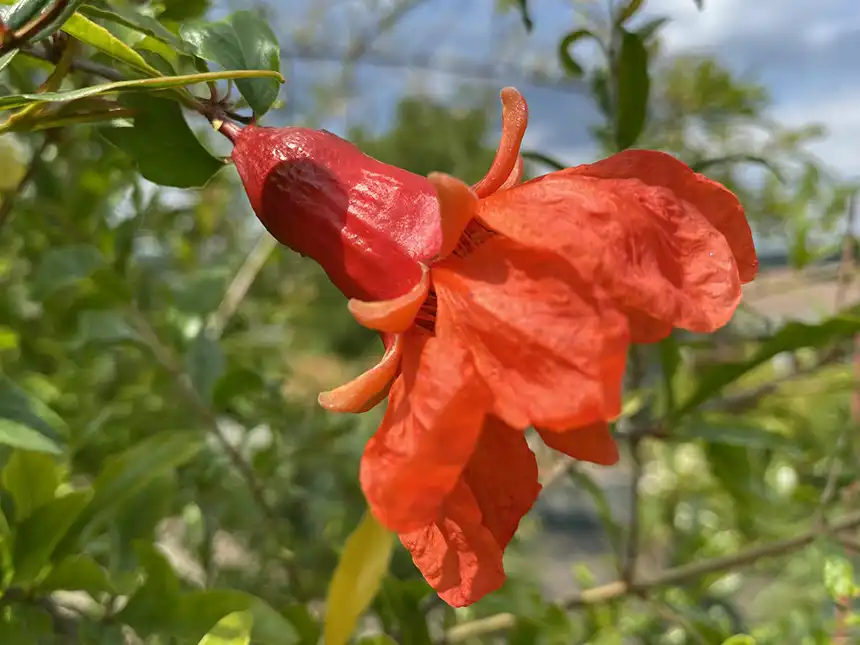
Granátové jablko je veľmi starobylá kultúra pôvodom z juhozápadnej Ázie, konkrétne z Iránu a častí Afganistanu a Pakistanu. Na Blízkom východe sa pestuje už tisíce rokov, pričom dôkazy naznačujú jeho pestovanie v Perzii (dnešný Irán) už v roku 3000 pred Kristom. V Azerbajdžane rastie granátovník voľne v prírode ako pôvodná endemická forma. Dôležitú úlohu pri komerčnom pestovaní granátového jablka zohral cielený výber, domestikácia a hybridizácia, ktoré prispeli k vzniku nových odrôd. Prítomnosť rozsiahlych porastov granátových jabĺk a rozmanitosť mnohých pôvodných miestnych odrôd vysokej kvality poukazujú na Azerbajdžan ako región mimoriadne vhodný na produkciu tohto ovocia. Podľa údajov z roku 2022 zaberali plantáže granátového jablka v Azerbajdžane 22.600 hektárov. Azerbajdžan dokáže spoľahlivo obohatiť granátovníkové plantáže o cenné originálne odrody. Zvládnutím moderných selekčných metód s ich obrovským potenciálom je teraz možné v kratšom čase aktualizovať a vylepšovať staršie odrody a s využitím existujúceho východiskového materiálu vytvárať nové, produktívne a vysokokvalitné odrody, ktoré spĺňajú všetky požiadavky na komerčnú produkciu plodov.
Granátové jablko je cenná ovocná, liečivá a atraktívna okrasná rastlina.
Vďaka bohatému chemickému zloženiu zaujíma granátové jablko jedno z popredných miest medzi subtropickým ovocím. Mnohí výskumníci zdôrazňujú, že plod granátového jablka je zdrojom cenných vitamínov a stopových prvkov: 27 – 52 % plodu tvorí šupka, 36 – 75 % šťava a 7 – 21 % semená. Šťava z granátového jablka obsahuje 8 – 20 % invertného cukru, 4 – 10 % kyseliny citrónovej, kyseliny jablčnej a kyseliny šťaveľovej, až 14 % vitamínu C, vitamíny B1, B2, B9 a B3, ako aj antokyány, katechíny, triesloviny, minerály (vápnik, horčík, draslík, mangán, kobalt), bioflavonoidy a fytoncídy. Šťava z granátového jablka obsahuje viac antioxidantov než akýkoľvek iný nápoj, či už je to červené víno, zelený čaj, čučoriedkový alebo brusnicový džús. Všetky časti granátovníka (plody, listy, kvety a korene) sa používajú na liečebné účely.
Botanická charakteristika a biologické vlastnosti
Granátovník púnsky, alebo Granátové jablko (Punica Granatum L.) patrí do čeľade vrbicovité (Lythraceae). Názov granátové jablko pochádza zo stredovekého latinského slova pōmum „jablko“ a grānātum „semenný“. Granátové jablko rastie prirodzene ako opadavý ker s 8–12 konármi. Kmeň a konáre sú tŕnisté. Listy sú malé, kopijovité, spočiatku červenohnedé, neskôr zelené. Kvitnutie začína 30 – 40 dní po začiatku vegetačného obdobia pri priemernej dennej teplote 20 °C a trvá 60 – 90 dní. Na krátkych výhonkoch sa tvoria zároveň plody aj kvety, čo je typické pre remontantné druhy rastlín. Kvety sú obojpohlavné, samoopelivé ale môžu byť opelené aj hmyzom. Na základe ich vzhľadu sa rozlišujú dva typy kvetov. Zvončekovité kvety sú krátke a majú nedostatočne vyvinutý semenník. Zvyčajne sa vyskytujú v zhlukoch po 3 – 5 kvetoch. Takéto kvety opadávajú bez toho, aby priniesli ovocie. Džbánovité kvety sa objavujú jednotlivo, majú dlhý piestik s dobre vyvinutým semenníkom a spravidla sa menia na plody.


Plody sú väčšinou guľovité a veľké (200 – 500 g, alebo viac). Šupka je v závislosti od odrody červená, ružová, oranžovo žltá a niekedy aj čierna. Plod granátového jablka je rozdelený na 9–12 komôr oddelených membránami. Každá komora obsahuje dva rady semenných obalov (nazývaných arily), v ktorých sú semená obklopené šťavnatou, červenou dužinou. Jeden plod obsahuje 400–700, niekedy 1000–1200 jedlých semien. Obdobie od začiatku vegetačného obdobia po zber plodov so sumou aktívnych teplôt 3500 °C je 5,5 – 6,5 mesiaca.
Granátové jablko je svetlomilná rastlina, dobre znáša prechodný nedostatok vody. Koreňový systém je silný, väčšina koreňov sa nachádza v hĺbke 40 – 60 cm. Zvyšné korene dosahujú hĺbku 1,5 – 2 m alebo viac. Zavlažovanie je potrebné v oblastiach s ročnými zrážkami menej ako 600 mm. Znáša zimné mrazy až do -16 °C. Granátové jablko sa pri normálnej starostlivosti dožíva a prináša ovocie niekoľko desiatok rokov. Divé granátovníky rastúce bez opatery v prírode rastú v tvare stromu a dožívajú sa aj vyše 120 rokov.
Ekologické vlastnosti a geografické rozšírenie granátového jablka
Rozsiahla oblasť rozšírenia siaha od púští až po subtrópy, osídlenie je možné pozorovať na rôznych reliéfoch, expozíciách a pôdach a schopnosť rýchlej regenerácie po zamrznutí a vyschnutí naznačujú výnimočnú plasticitu granátovníka. Orografia, pôdy, vegetácia, podnebie a mikroklíma Azerbajdžanu sú veľmi rozmanité. Granátové jablko je však rozšírené takmer vo všetkých regiónoch republiky, s výnimkou vysokohorských a silne zasolených oblastí.
Granátové jablká azerbajdžanského pôvodu prešli v pestovaní a šľachtení dlhou evolučnou cestou a dnes vykazujú vysoké kvalitatívne vlastnosti a väčší polymorfizmus v porovnaní s endemickými a prechodnými formami. V Azerbajdžane možno pozorovať širokú škálu variácií a rozmanitosť foriem, od divo rastúcich foriem s extrémne malými plodmi, až po kultúrne odrody s veľmi veľkými plodmi a rozmanitými vlastnosťami.
Najlepšie granátové jablká rastú v oblastiach so suchým alebo polosuchým podnebím. Vo vlhkých oblastiach sú plody nižšej kvality a pri daždi počas dozrievania praskajú. V tropických oblastiach granátové jablká drevnatejú a produkujú len malú úrodu. Granátovník rastie v suchých subtrópoch, ale uprednostňuje pobrežné pásy pozdĺž morí a riek. Najlepšie sa granátovníku darí v oblastiach s miernymi zimami, kde teploty neklesajú pod -12 °C. Granátové jablko tvorí pri nedostatku svetla dlhé, slabé konáre, má málo listov a slabo kvitne.
Najrozšírenejšie odrody granátového jablka vo svete
Existuje viac ako 500 odrôd granátového jablka, z ktorých sa približne 60 pestuje na celom svete. Tu nájdete popis niektorých najrozšírenejších odrôd na svete.
Azerbaijani Guleysha (Azerbajdžan). Ker strednej výšky (3 m), husto rozvetvený. Plody sú veľké (300 - 400 g), guľaté až podlhovasté. Šupka je tenká, lesklá, červeno ružová. Arily sú veľké, červené, so stredne veľkými semenami. Šťava je sladkokyslá, chutná a jasnočervená. Obsahuje až 20 % cukru a 1,8 % kyselín. Výťažnosť šťavy je 55 %. Plody dozrievajú v októbri. Priemerná úroda z kríka je 45 - 50 kg.
Pink Guleysha (Azerbajdžan). Ker je stredne vysoký (3 - 4 m), husto rozvetvený. Plody majú guľatý až predĺžený tvar, sú veľké (200 - 250 g), ale pri nízkej úrode dosahujú hmotnosť až 400 - 600 g. Šupka je tenká, krémovo-ružová. Arily sú stredne veľké, tmavo čerešňovej farby. Výťažnosť šťavy je 54,5 %, obsah cukru je 15,6 % a kyselín 1,3 %. Šťava je sladkokyslá. Plody dozrievajú v októbri. Úroda z kríka je 35 - 45 kg.
Gyrmyzy Guleysha (Azerbajdžan). Ker je veľký, rozložitý. Plody guľatého tvaru sú po dozretí veľké (350 - 500 g) alebo stredné (250 - 300 g). Šupka je karmínovo červená s výraznými pruhmi. Arily sú veľké, tmavo čerešňovej farby, so sladkokyslou šťavou. Výťažnosť šťavy je 53,5 %, obsah cukru 15,5 % a kyselín 1,5 %. Šťava je sladkokyslá. Plody dozrievajú koncom októbra. Priemerná úroda z kríka je 50 – 55 kg.
Gyrmyzy Gabyk (Azerbajdžan). Ker je vysoký 4 m, s menšími tŕňmi. Plody sú veľké (350 – 450 g), guľaté. Šupka je stredne hrubá a jasne červená. Arily sú veľké, malinovočervené. Šťava je tmavočervená, sladkokyslá a veľmi chutná. Výťažnosť šťavy je 52,4 %, obsah cukru 14,5 % a kyselín 2,1 %. Plody dozrievajú koncom októbra a skladujú sa 4 - 5 mesiacov. Produktivita na krík je 45 - 50 kg.
Nazik Gabyk (Azerbajdžan). Ker dorastá do výšky 4 m. Plody sú veľké (400 g) a tmavočervené. Šupka je tenká. Arily sú veľké, šťava je sladkokyslá. Výťažnosť šťavy je 48,8 %, obsahuje 12,3 % cukru a 2,6 % kyselín. Plody dozrievajú začiatkom alebo v polovici októbra. Z každého kríka sa zozbiera 35 - 40 kg plodov. Plody sa skladujú 3 - 4 mesiace.
Bala Mursal (Azerbajdžan). Považuje sa za jednu z najlepších azerbajdžanských odrôd. Ker dosahuje výšku 3 m, s malým počtom tŕňov. Plody sú plocho-guľovitého tvaru s hmotnosťou okolo 300 g, svetlej malinovočervenej farby. Šupka je hrubá. Arily sú stredne veľké, tmavočervené. Výťažnosť šťavy je 54,3 %, šťava sa mení od sýtočervenej po malinovú. Obsahuje až 16 % cukru a 1,5 % kyselín. Chuť je sladkokyslá. Plody dozrievajú začiatkom októbra a skladujú sa 3 - 4 mesiace. Z každého kríka sa zozbiera v priemere 30 - 40 kg úrody.
Shah Nar (Azerbajdžan). Stredne veľký, husto rozvetvený ker. Plody sú stredne veľké (300 - 350 g), guľaté alebo hruškovité. Šupka je stredne hrubá, svetlo kávovej a červenej farby. Arily sú stredne veľké. Chuť je príjemná, sladkokyslá. Výťažnosť šťavy je 53,9 %, obsahuje 13,4 % cukru a 2,1 % kyselín. Plody dozrievajú v druhej polovici októbra. Z kríka sa získa 30 - 35 kg plodov. Plody sa skladujú až 6 mesiacov.
Veles Nar (Azerbajdžan). Stredne veľký ker. Plody sú stredne veľké (200 - 250 g), guľato-oválne. Šupka je hrubá, svetlo krémovej farby, pokrytá tmavohnedým odtieňom, pripomínajúcim kôru hrabu. Arily sú stredne veľké, ružovo červené, sladké, s nízkou kyslosťou. Výťažnosť šťavy je 50,2 %. Plody dozrievajú do konca októbra a skladujú sa 3 - 4 mesiace. Produktivita je vysoká. Z kríka sa získa 40 - 45 kg plodov.
VIR No.1 (Azerbajdžan). Ker je rozložitý, strednej výšky (2,5 - 3 m). Kvety sú veľké, svetločervené. Plody sú veľké (350 - 400 g), guľaté, niekedy hruškovitého tvaru. Šupka je hrubá, svetložltá. Arily sú svetločervené, s príjemnou chuťou. Výťažnosť šťavy je vysoká (56,7 %). Plody dozrievajú koncom októbra. Z každého kríka sa zozbiera približne 45 kg úrody.
Akdona (Uzbekistan). Obľúbená odroda s veľkými semenami, nazývaná aj Tyuyatish (ťaví zub). Ker je veľký, ale zároveň kompaktný. Plody sú plocho-guľovité. Hmotnosť plodu je v priemere 250 g, niekedy dosahuje hmotnosť až 600 g alebo viac. Šupka je hladká, lesklá, svetlej farby s jemným karmínovým rumencom. Arily sú ružové, semená sú predĺžené. Šťava je svetloružová, veľmi sladká, obsahuje približne 15 % cukru a asi 0,6 % kyselín. Plody dozrievajú začiatkom októbra a skladujú sa približne dva mesiace. Výnos je 20 - 25 kg na krík alebo viac.
Kyzyl Anor (Uzbekistan). Považuje sa za jednu z najlepších odrôd pestovaných v Uzbekistane s menšími guľatými až plocho-guľovitými plodmi, ale niekedy sú plody veľké a dosahujú 600 - 800 g. Šupka je tenká alebo stredne hrubá. Arily sú stredne veľké, tmavočervené, sladkokyslé. Farba šťavy červená až tmavo čerešňová, obsah cukru 15,5 % a obsah kyselín 1,9 %. Plody dozrievajú na začiatku októbra. Skladujú sa približne 3 - 4 mesiace.
Kay-Acik-Anor (Uzbekistan-Tadžikistan). Ker je veľký. Plody sú veľké (300 - 400 g), guľaté. Obsahujú až 16 % cukru a 1,4 % kyselín. Plody dozrievajú v polovici októbra. Prepravovateľnosť a trvanlivosť plodov sú dobré. Produktivita kríka je až 50 kg.
Kazake Anor (Uzbekistan). Plody sú veľké (300 - 400 g), guľaté, zeleno-žltej farby. Šupka je stredne hrubá, arily sú veľké. Šťava je malinovočervená, sladkokyslá, príjemná a obsahuje až 20 % cukru a 1,85 % kyselín. Výťažnosť šťavy je 45 %. Plody dozrievajú v prvej polovici októbra. Produktivita je vysoká.
Wonderful (Kalifornia, USA). Táto odroda s mäkkými semenami je najrozšírenejšia v USA, kde zaberá viac ako polovicu pestovateľskej plochy granátových jabĺk. Plody sú malé, s hmotnosťou 180 - 220 g, ale veľmi chutné a sladké. Farba plodov je bielo-žltá s jemným karmínovým rumencom. Plody dozrievajú začiatkom októbra. Semená sú veľmi malé, mäkké, šťava je svetlo malinová. Zrelé plody obsahujú 13 % cukru a 0,4 % kyselín. Výnos je približne 15 kg na krík. Plody sa skladujú 2 mesiace.
Siyah Dane (Irán). Plody sú veľmi veľké, až 640 - 700 g, guľaté, tmavo karmínové, svetlé, lesklé. Šupka je tenká. Šťava je tmavo čerešňová, sladkokyslá, jemná, príjemná, jej výťažnosť je až 61,89 %. Obsah cukru je 19,63 % a kyselín 1,62 %. Plody dozrievajú v prvej dekáde októbra. Úroda z kríka je 35 - 40 kg.
Saveh (Irán). Plody sú veľké, až 400 - 600 g, žiarivo červené. Šupka je tenká, červená, šťava tmavo karmínová, sladkokyslá, jej výťažnosť je 52,17 %, obsah cukru 19,55 % a kyselín 1,83 %. Plody dozrievajú v polovici októbra. Úroda z jedného kríka je 30 kg.
Malta (Španielsko). Vynikajúca dezertná odroda s mäkkými semenami. Plody sú veľké, až 350 - 400 g, zelenkasté so žiarivo červeným rumencom. Šupka je tenká. Šťava je svetločervená, sladká a jemná, jej výťažnosť je až 60,03 %. Semená sú mäkké, jedlé. Obsah cukru je 18,0 % a kyselín 1,05 %. Plody dozrievajú v prvej dekáde októbra. Úroda z jedného kríka je 32 kg.
Šľachtenie odrôd granátového jablka v Azerbajdžane
Výskumná stanica Goychay Vedeckého výskumného ústavu ovocia a čaju Ministerstva poľnohospodárstva Azerbajdžanu (SRIFTG) je jedno z najdôležitejších centier genetických zdrojov granátových jabĺk. Ich zbierka tvorí pôvodné a vyšľachtené azerbajdžanské odrody, ako aj introdukované odrody.
Zlepšenie sortimentu granátových jabĺk v Azerbajdžane sa vykonáva prostredníctvom klonového výberu a hybridizácie. Vďaka cielenej selekcii sa odrody granátového jablka dostali na vysokú kvalitatívnu úroveň. Výsledkom klonálnej variability sú mutácie. Spontánne mutácie u granátového jablka a rozdiely oproti pôvodnej odrode sa prejavujú v zmenách farby a kvality plodov, doby dozrievania, úrody a vzrastu kríkov. Medzi hlavnými štandardnými odrodami (Pink Guleysha, Gyrmyzy Guleysha, Bala Mursal, Gyrmyzy Gabyk, Nazik Gabyk, Meles-Shelly a VIR) sa nachádzajú rastliny s pozitívnymi aj negatívnymi odchýlkami. Výber klonov je o vylepšovaní existujúcich odrôd. To si vyžaduje prísnu kontrolu odrodovej čistoty a vnútro odrodový výber.
Morfologické charakteristiky plodov, ako je počet plodov a výnos na krík, hmotnosť a tvar plodov, farba, množstvo a kvalita šťavy, sú dôležitými ukazovateľmi pre výber genotypu ako komerčného produktu. Experimentálne údaje od mnohých šľachtiteľov ukázali veľmi dôležitý význam opakovaného kríženia s jedným z hybridov alebo najlepších kultivarov. Každá nová generácia je nositeľom vlastností oboch rodičov alebo predkov. V každej ďalšej generácii boli vyselektované najzdravšie a najproduktívnejšie odrody granátového jablka odolnejšie voči nízkym teplotám. Z odrôd, ktoré vyšľachtila azerbajdžanská SRIFTG, možno spomenúť nasledujúce dve:
Nasimi (Spring x Bala Mursal+Agdam+Gyrmyzy Guleysha+Garabagh). Plody sú stredne veľké až veľké (350 - 400 g), guľaté alebo plocho-guľovité, červené s krémovými medzerami s červenými škvrnami, pruhmi a bodkami. Šupka je tenká. Šťava so semenami tvorí 69,8 % plodu. Šťava je sladkokyslá, čerešňovo červená, jej výťažnosť je 59,2 %. Obsah cukru je 18,3 %, obsah kyselín 2,03 %. Semená tvoria 10,6 % plodu. Úroda v 7. roku dosahuje 40 kg na ker.
Vurgun (Spring x Azerbaijan). Plody sú veľké (415 g), guľaté, so základnou krémovou farbou, s červenou krycou farbou po celom plode, s pruhmi a bodkami. Šupka je stredne hrubá, šťava je sladkokyslá, tmavočervená, jej výťažnosť je 53,8 %, obsah cukru je 18,8 % a kyselín 1,98 %. Semená tvoria 16,8 % plodu. Úroda v 7. roku je 36 kg na ker.
Šľachtenie odrôd s mäkkými semenami
Semená granátového jablka sú zvyčajne veľmi tvrdé a nepohodlné pri konzumácii. Výhodou sú preto odrody s mäkkými semenami. Azerbajdžanská kolekcia odrôd zahŕňa staršie odrody s mäkkými semenami Malta, Paper a Iranian. Všetky tieto odrody chutia sladko, ale sú citlivejšie na nízke pestovateľské teploty ako miestne odrody. Malta je vysoko kvalitná odroda, ale má neštandardnú farbu. Paper má tiež bledú farbu a je silne poškodzovaný obaľovačom jablčným. Iranian má krémovú farbu s jemným červenkastým rumencom a chýba mu šťavnatosť. Tieto staršie odrody boli využité pri krížení s cieľom získať potomkov s lepšími znakmi a vlastnosťami. Výsledkom kríženia odrody Paper boli dva semenáče s mäkkými semenami ktoré boli použité v nasledujúcej hybridizácii. V ďalšom období boli spomedzi získaných selekčných potomkov vybrané rastliny s mäkkými semenami a plodmi so sladkou šťavou. Z nich boli vyšľachtené najkvalitnejšie odrody z hľadiska kvality a farby šťavy: Mekhseti, Dessert Azerbaijani a Aleko.
Mekhseti (Spring x Azerbaijan). Plody sú veľké (350 - 400 g), guľaté až plocho-guľovité, tmavo karmínové a jasnočervené. Šupka je tenká. Výťažnosť šťavy so semenami je 67,4 %. Šťava je sladká, jemná, tmavá malinovočervená a má výťažnosť 56,3 %. Obsahuje 20,29 % cukru a 0,31 % kyselín. Semená sú malé, mäkké a jedlé, tvoria 11,1 % plodu. Plody dozrievajú začiatkom októbra. Výnos 7-ročného kríka je 26,7 kg.
Dessert Azerbaijani (Azerbaijan x Malta). Plody sú stredne veľké až veľké (350 g), guľaté, tmavo karmínové a červené. Šupka je veľmi tenká. Šťava so semenami tvorí 71,7 % hmotnosti ovocia. Výťažnosť šťavy je 59,3 %, obsahuje 17,01 % cukru a 0,73 % kyselín. Semená tvoria 12,4 % hmotnosti plodu, sú mäkké a jedlé. Plody dozrievajú začiatkom októbra. Sedemročný ker produkuje 22,0 kg ovocia.
Aleko (Spring x zmes peľov Bala Mursal + Agdam + Gyrmyzy Guleysha + Garabagh). Plody sú veľké (500 g), ploché až guľaté, intenzívne karmínovočervené s podkožnými svetlozelenými bodkami. Šupka je tenká. Šťava je sladkokyslá, tmavo čerešňová, jemná, pripomínajúca víno a veľmi chutná. Jej výťažnosť je až 63,5 %. Obsahuje 20,8 % cukru a 2,01 % kyselín. Semená sú malé, mäkké, predĺžené, tvoria 10,1 % plodu. Plody dozrievajú v prvej dekáde októbra. Výnos 7-ročného kríka je 28,8 kg.









